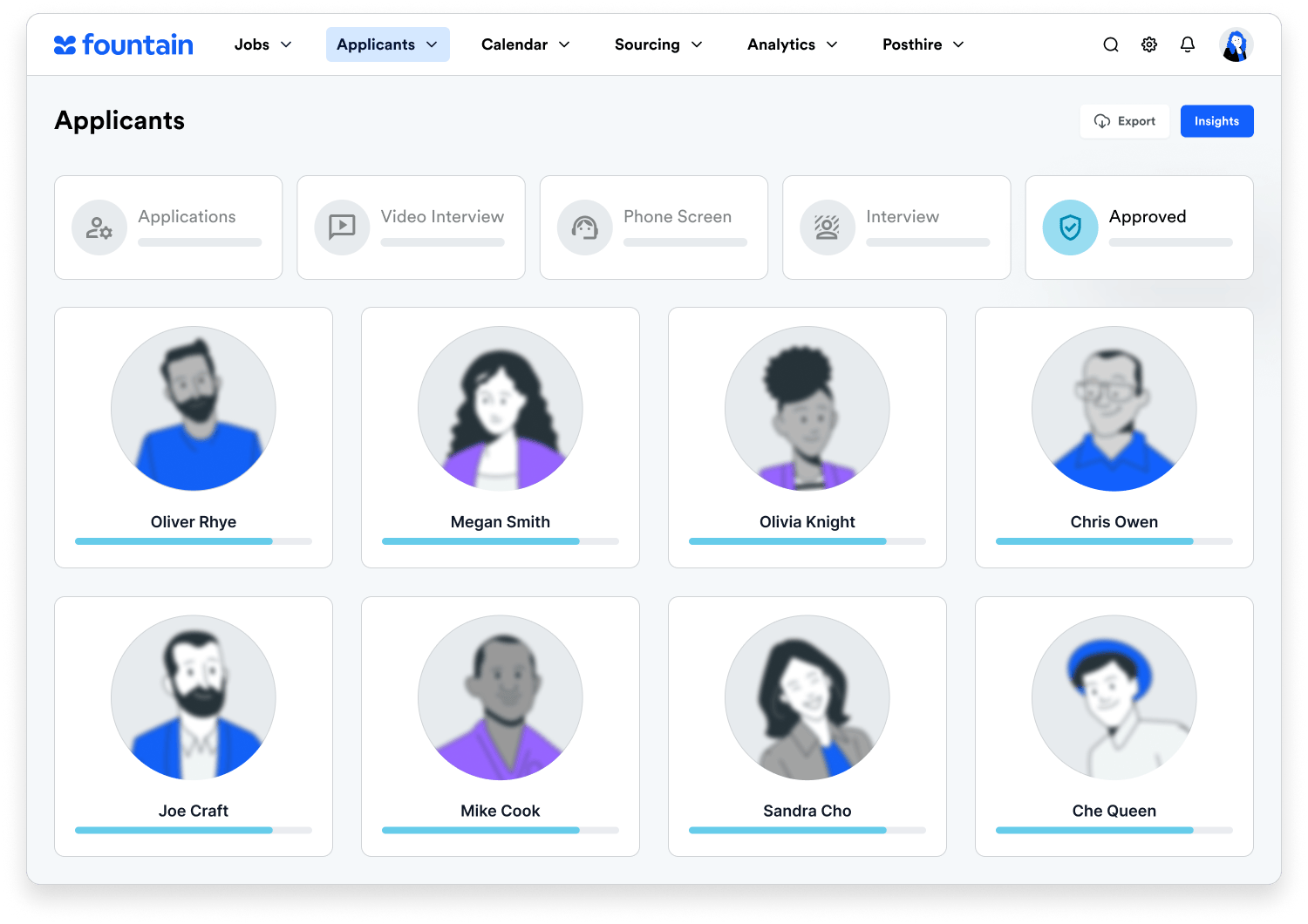You may already know that hourly workers make up approximately 60% of the U.S. workforce. But what you might not know is that hiring these workers requires a completely different set of objectives, strategies, and tools than hiring workers for corporate or salaried positions. It requires a dynamic and efficient high volume hiring strategy.
High volume hiring often requires recruiting teams to perform taxing, time-consuming outreach; manually sort through hundreds (maybe thousands) of applications; lose candidates due to slow processes; and a lack of data from which to glean any sort of learnings about efficiency. To tackle these roadblocks, hiring teams need to embrace creativity and persistence, and develop the right strategies to source and recruit the kinds of workers who will add real value to the business.
In this post, we’ll reveal 11 easy steps to building a high volume hiring strategy that ensures you get the talent you need, fast.
The challenges of high volume hiring
Hiring high volumes of workers can be daunting and draining, especially for hiring teams that don’t have the right tools and strategies.
Ambiguity in job descriptions might deter job seekers from applying. Manual processes slow down the funnel, causing applicants to drop out and search for jobs that can get them hired faster. And a clunky system that isn’t optimized for mobile devices won’t align with job seekers’ preferences and tendencies.
But above all, the following challenges seem to have the biggest impact on recruitment teams’ progress.
- Poor sourcing methods. It seems as though a new recruiting platform pops up every day, especially in the time of AI. With so many options, it can be hard to narrow and select the best hiring solutions to get you the right workers so you’re not wasting time on the wrong fit.
- Meeting candidates’ expectations. Today’s candidates want speed, simplicity, and personalization. In order to reach your ideal applicant, your hiring process needs to work with their lifestyle.
- Slow, cumbersome processes. Dated ATSes require too much of the recruiter, leaving little time for the more important tasks.
Every hiring strategy can be improved
The current high volume hiring landscape for recruiters is saturated with solutions promising to simplify and streamline your operations. Modern hiring methods like the applicant tracking system have been outfitted with the latest in automation and artificial intelligence to help free up time for recruiters.
On the candidate side, job seekers have more options than ever and are more likely to favor the processes that get them hired the fastest. Therefore, it’s essential for recruitment teams to build effective high volume hiring strategies in order to stay competitive in the race for top talent.
Strategies for high-volume hiring
Ready to build a modern high volume hiring process that gets you the right talent, faster? Use the following tactics to get started:
- Free and paid hiring platforms
- Candidate sourcing tools
- Social media
- Mobile-first platforms
- Automation
- Innovative staff perks
- Referral programs
- Continuous hiring pipelines
Use both free and paid hiring platforms
Thousands of jobs are posted to free job platforms like Indeed every day, so it might be difficult for your ideal candidates to see your listings if this is the only platform you use. Paid job search platforms allow you to narrow your search to find the right type of applicant, and also can expand your reach to different geographies if you’re hiring for multiple locations.
Optimize candidate sourcing tools
You may be devoting a large chunk of your recruiting budget to sourcing, but what if we told you you didn’t need to do this? In short, work smarter, not harder with these sourcing tools.
HireEZ
HireEZ is a free browser extension that lets you target, engage, and hire qualified workers so you can focus more on the human connection aspect of the recruitment process.
MightySourcer
From MightyRecruiter, MightySourcer is another Chrome extension that allows you to find star job candidates and create profiles based on their information from LinkedIn, Facebook, or other social media networks.
Hunter
Hunter is a top candidate sourcing tool because that gives you the means to connect with passive candidates.
Use social media channels to curate your employer brand
Social media shouldn’t just be used for posting jobs. It’s also an ideal platform to showcase the culture of your workplace.
Part of your recruiting strategy should involve curating a positive employer brand through your website and social media. Interested candidates will likely search for your organization’s online presence to help them make their decision, so use this opportunity to showcase your workplace in the best light.
Click here to learn about five companies who are doing social recruiting right.
Use mobile-first platforms

Using a mobile-first platform can help provide the best candidate experience since most hourly job seekers are applying on their phones. Mobile-first recruiting is especially helpful with tasks like interview scheduling: Candidates can select time slots based on the hiring manager’s availability. Candidates also can create video-recorded interviews directly on their mobile devices.
A mobile-first system also enables communication with candidates through SMS and WhatsApp.
Embrace automation
Your modern hiring technology should be able to automate communication in order to provide the best candidate experience, as well as enable your recruiters to manage a high number of candidates more efficiently. With automation, candidates also can quickly complete the hiring process through electronic document signing and document uploads.
This type of smart hiring enables you to automate repetitive tasks, which allows you to spend more time on a one-to-one basis with candidates.
Promote innovative perks
Offering a competitive wage is an important aspect of any job, and essential for hiring hourly workers. But to truly stand out from competitors and attract the highest-quality candidates, offer something that will speak to applicants’ lives outside of work.
For example, Walmart started offering on-the-job English lessons to Spanish-speaking workers as an incentive for entry-level employees in the Southern states. Walmart has recently expanded this service to include a free online school program. This offering has boosted Walmart’s reputation as a more employee-friendly place, as opposed to a corporation that does not value its workers.
Your recruitment strategy for hourly positions should include perks that can help employees not only enjoy their time at work but also their time away. Provide extra perks like working from home (if possible), a collaborative open office environment, or occasional company social events.
Create a referral program
Referral bonuses can be a rewarding way to task your existing or former workers with finding quality talent. Reengaging past employees who have left to fulfill other obligations can help you fill roles when your busy season hits, or they can provide recommendations for workers who might have gaps in their schedule and are looking to fill them.
Additionally, a referral program can incentivize current employees to recommend people who might be a good fit for open roles. In this way, your employees serve as brand ambassadors, and you can reward them if their referral is hired.
Build a hiring pipeline
A hiring pipeline provides you with a steady stream of applicants who have applied for your job openings but didn’t make it to the offer stage. When you have a new job opening, you can tap into this existing resource of already-qualified candidates, saving valuable sourcing time. By keeping this pipeline active, you’re passively building a pool of candidates you can easily access whenever you have openings to fill.
How to update your hiring process for higher volume
You don’t need to build an entire strategy from scratch. Consider making these slight tweaks to your existing processes:
- Simplified applications
- Reduced time-to-hire
- Revised job descriptions
Simplify the application process
Hourly workers move through job openings fast. if they find your application process to be too lengthy, they will simply move on to the next recruiter, which might be a competitor. So it’s imperative to have an application portal where candidates can submit their applications anytime, from anywhere.
Reduce time-to-hire
Reducing time-to-hire is a key part of an employee recruitment strategy. If you take too long to make contact or move your candidates through the recruitment funnel, they’ll move on to the next opportunity. See if you can automate manual tasks in your process or consolidate tasks with the help of technology.
Make job descriptions clear and compelling
Your job application should be easy to skim. It shouldn’t include complex words or vague industry terms, but instead should be written in plain and understandable language.
Clearly state the skills that are required, the experience needed, and day-to-day duties so the candidate knows exactly what to expect.
Providing a clear job description increases the chances that only qualified applicants will apply for the job. With ambiguous job descriptions, candidates may apply without fully reading, which may cause less-qualified applicants to sneak through to the final stages.

How analytics can help
Once you have your high volume hiring strategy in place, you’ll need a way to track whether it’s working and meeting your hiring needs. This is where an ATS with data analytics functionalities comes in handy.
Your ATS should measure and monitor important hiring metrics such as time-to-hire and cost-per-hire. Using a modern hiring platform will enable you to analyze different aspects of your recruitment strategy and make changes to areas that aren’t showing positive results. Paired with the capabilities above, an all-encompassing ATS will set you on a path toward hiring success.
Hiring strategy FAQs
When building your hiring strategy, you may find yourself asking the following questions. See below for our answers to these FAQs.
- What is a hiring strategy?
- A hiring strategy is a plan put in place by recruitment teams to identify and find the best candidates for open jobs.
- What are the most important hiring KPIs?
- The most important hiring KPIs include time-to-hire, cost-per-hire, application completion rate, and conversion rate.
- What is high volume hiring?
- High volume hiring is defined as the process of hiring a large volume (dozens, hundreds, or thousands) of workers in a short time period. This type of hiring typically applies to hourly or frontline roles, while corporate roles require a different method of recruiting.
- What does hiring software do?
- Hiring software helps recruiters manage the entire hiring process digitally and track applicants’ movement through the various hiring stages. Hiring software also can provide data and insights to help recruiters improve their hiring efficiency.
- What tools can I use to optimize my hiring strategy?
- There are multiple tools you can use to optimize your hiring strategy. Within an ATS, you can post jobs to multiple job boards; activate premade assessments to test your candidates’ abilities; reach candidates where they are through mobile-friendly applications; and allow them to upload their information and documents directly from their devices.
Source and recruit more efficiently at high volumes
Your high volume hiring strategy should cover the entire hiring funnel, from sourcing and recruitment to onboarding. Today’s hourly workers want (and need) to be recruited quickly, sometimes in a matter of days, so your hiring technology should be able to match this pace while also allowing you visibility into critical hiring insights.
To start hiring fast and efficiently, click here to see how Fountain can help.

